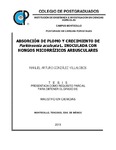| dc.contributor.author | González Villalobos, Manuel Arturo | |
| dc.creator | GONZÁLEZ VILLALOBOS, MANUEL ARTURO;784492 | |
| dc.date.accessioned | 2019-09-10T13:49:41Z | |
| dc.date.available | 2019-09-10T13:49:41Z | |
| dc.date.issued | 2018-12 | |
| dc.identifier.uri | http://hdl.handle.net/10521/4045 | |
| dc.description | Tesis (Maestría en Ciencias Forestales).- Colegio de Postgraduados, 2018. | es_MX |
| dc.description.abstract | Se evaluó el efecto del Pb en la germinación y crecimiento de plántulas de Parkinsonia aculeata L. y su potencial de fitorremediación al inocularla con Rhizophagus intraradices en sustrato contaminado con Pb. El primer ensayo estudió el efecto de dos compuestos de Pb en la germinación de semillas y el crecimiento temprano de plántulas de P. aculeata en condiciones controladas e invernadero. En condiciones controladas, las soluciones de PbCl2 o de Pb(NO3)2, inhibieron significativamente la germinación, y el peso seco del vástago y radícula. En invernadero, los compuestos de Pb inhibieron el crecimiento de radícula, pero solo el Pb(NO3)2 redujo significativamente el peso seco de la misma; así, el efecto del Pb difiere con base en el compuesto de Pb utilizado, siendo más tóxico el Pb(NO3)2 que el PbCl2. La inhibición que ocasionan ambos compuestos de Pb fue más pronunciada en condiciones controladas que en invernadero. El segundo estudio evaluó el crecimiento y la capacidad de absorción de Pb por P. aculeata al ser inoculada con R, intraradices, y expuesta a las siguientes concentraciones de Pb [Pb(NO3)2]: 0, 40, 80, 160, 320, 640 mg L-1. R. intraradices favoreció el crecimiento y el peso seco de la parte aérea, pero redujo el crecimiento de raíz. Los niveles de Pb aplicado ni la inoculación micorrízica no tuvieron efecto en el rendimiento cuántico máximo del PSII y en el rendimiento fotosintético. Las concentraciones de Pb no afectaron la colonización micorrízica; pero R. intraradices favoreció la absorción del Pb en raíz, y su translocación a la parte aérea; además, mejoró la absorción de P por las plantas. _______________ LEAD UPTAKE AND GROWTH OF Parkinsonia aculeata L. INOCULATED WITH ARBUSCULAR MYCORRHIZAL FUNGI. ABSTRACT: The effect of Pb was evaluated on the germination and growth of seedlings of Parkinsonia aculeata L. and its phytoremediation potential was evaluated when inoculated with Rhizophagus intraradices in substrate contaminated with Pb. The first trial studied the effect of two Pb compounds on seed germination and early growth of P. aculeata seedlings under controlled conditions and greenhouse. Under controlled conditions, PbCl2 or Pb(NO3)2 solutions significantly inhibited germination, and the dry weight of the stem and radicle. In the greenhouse, the Pb compounds inhibited the radicle growth, but only the Pb (NO3)2 significantly reduced the dry weight thereof; thus, the effect of Pb differs based on the Pb compound used, being Pb (NO3)2 more toxic than PbCl2. The inhibition caused by both Pb compounds was more pronounced under controlled conditions than in the greenhouse. The second study evaluated the growth and absorption capacity of Pb by P. aculeata when inoculated with R. intraradices, and exposed to the following concentrations of Pb [Pb(NO3)2]: 0, 40, 80, 160, 320 , 640 mg L-1. R. intraradices favored growth and dry weight of the aboveground mass, but reduced root growth. The levels of Pb applied and the mycorrhizal inoculation had no effect on the maximum quantum yield of the PSII and on the photosynthetic performance. Pb concentrations did not affect mycorrhizal colonization; but R. intraradices favored the absorption of Pb in root, and its translocation to the aboveground tissues; in addition, it improved the absorption of P by the plants. | es_MX |
| dc.description.sponsorship | Consejo Nacional de Ciencia y Tecnología (CONACyT). | es_MX |
| dc.format | pdf | es_MX |
| dc.language.iso | spa | es_MX |
| dc.rights.uri | http://creativecommons.org/licenses/by-nc-nd/4.0 | es_MX |
| dc.subject | Palo verde | es_MX |
| dc.subject | Metal pesado | es_MX |
| dc.subject | HMA | es_MX |
| dc.subject | Contaminación | es_MX |
| dc.subject | Fitorremediación | es_MX |
| dc.subject | Mexican paloverde | es_MX |
| dc.subject | Heavy metal | es_MX |
| dc.subject | Pollution | es_MX |
| dc.subject | Phytoremediation | es_MX |
| dc.subject | Ciencias Forestales | es_MX |
| dc.subject | Maestría | es_MX |
| dc.subject.classification | CIENCIAS AGROPECUARIAS Y BIOTECNOLOGÍA::CIENCIAS AGRARIAS::CIENCIA FORESTAL::CONSERVACIÓN | es_MX |
| dc.title | Absorción de plomo y crecimiento de Parkinsonia aculeata L. inoculada con hongos micorrízicos arbusculares. | es_MX |
| dc.type | Tesis | es_MX |
| Tesis.contributor.advisor | Martínez Trinidad, Tomás | |
| Tesis.contributor.advisor | Alarcón, Alejandro | |
| Tesis.contributor.advisor | Plascencia Escalante, Francisco Ofelia | |
| Tesis.date.submitted | 2018-12 | |
| Tesis.date.accesioned | 2019 | |
| Tesis.date.available | 2019 | |
| Tesis.format.mimetype | pdf | es_MX |
| Tesis.format.extent | 1,673 KB | es_MX |
| Tesis.subject.nal | Parkinsonia aculeata | es_MX |
| Tesis.subject.nal | Micorrizas arbusculares vesiculares | es_MX |
| Tesis.subject.nal | Vesicular arbuscular mycorrhizae | es_MX |
| Tesis.subject.nal | Plomo | es_MX |
| Tesis.subject.nal | Lead | es_MX |
| Tesis.subject.nal | Germinación de las semillas | es_MX |
| Tesis.subject.nal | Seed germination | es_MX |
| Tesis.rights | Acceso abierto | es_MX |
| Articulos.subject.classification | Descontaminación de suelos | es_MX |
| dc.type.conacyt | masterThesis | es_MX |
| dc.identificator | 6||31||3106||310601 | es_MX |
| dc.contributor.director | MARTÍNEZ TRINIDAD, TOMÁS;37287 | |
| dc.audience | generalPublic | es_MX |


